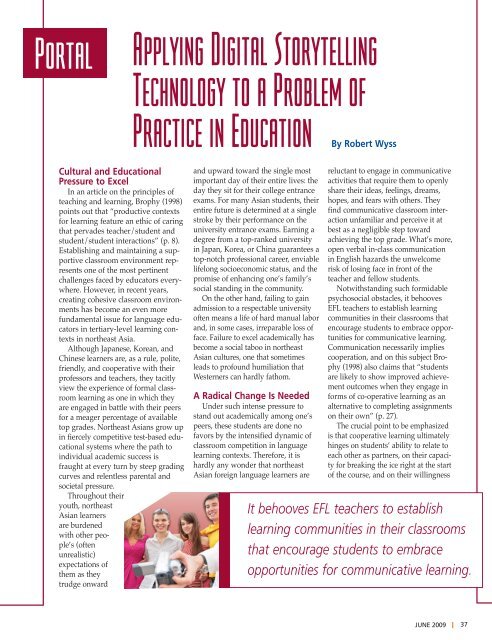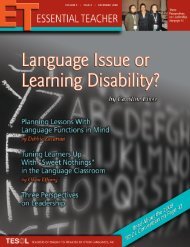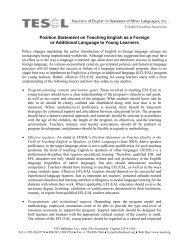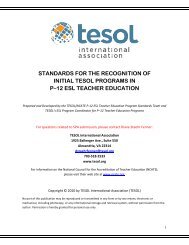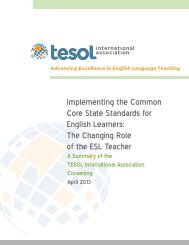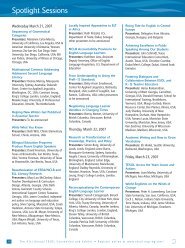Full Issue (PDF) - TESOL
Full Issue (PDF) - TESOL
Full Issue (PDF) - TESOL
Create successful ePaper yourself
Turn your PDF publications into a flip-book with our unique Google optimized e-Paper software.
Portal<br />
Applying Digital Storytelling<br />
Technology to a Problem of<br />
Practice in Education By Robert Wyss<br />
Cultural and Educational<br />
Pressure to Excel<br />
In an article on the principles of<br />
teaching and learning, Brophy (1998)<br />
points out that “productive contexts<br />
for learning feature an ethic of caring<br />
that pervades teacher/student and<br />
student/student interactions” (p. 8).<br />
Establishing and maintaining a supportive<br />
classroom environment represents<br />
one of the most pertinent<br />
challenges faced by educators everywhere.<br />
However, in recent years,<br />
creating cohesive classroom environments<br />
has become an even more<br />
fundamental issue for language educators<br />
in tertiary-level learning contexts<br />
in northeast Asia.<br />
Although Japanese, Korean, and<br />
Chinese learners are, as a rule, polite,<br />
friendly, and cooperative with their<br />
professors and teachers, they tacitly<br />
view the experience of formal classroom<br />
learning as one in which they<br />
are engaged in battle with their peers<br />
for a meager percentage of available<br />
top grades. Northeast Asians grow up<br />
in fiercely competitive test-based educational<br />
systems where the path to<br />
individual academic success is<br />
fraught at every turn by steep grading<br />
curves and relentless parental and<br />
societal pressure.<br />
Throughout their<br />
youth, northeast<br />
Asian learners<br />
are burdened<br />
with other people’s<br />
(often<br />
unrealistic)<br />
expectations of<br />
them as they<br />
trudge onward<br />
and upward toward the single most<br />
important day of their entire lives: the<br />
day they sit for their college entrance<br />
exams. For many Asian students, their<br />
entire future is determined at a single<br />
stroke by their performance on the<br />
university entrance exams. Earning a<br />
degree from a top-ranked university<br />
in Japan, Korea, or China guarantees a<br />
top-notch professional career, enviable<br />
lifelong socioeconomic status, and the<br />
promise of enhancing one’s family’s<br />
social standing in the community.<br />
On the other hand, failing to gain<br />
admission to a respectable university<br />
often means a life of hard manual labor<br />
and, in some cases, irreparable loss of<br />
face. Failure to excel academically has<br />
become a social taboo in northeast<br />
Asian cultures, one that sometimes<br />
leads to profound humiliation that<br />
Westerners can hardly fathom.<br />
A Radical Change Is Needed<br />
Under such intense pressure to<br />
stand out academically among one’s<br />
peers, these students are done no<br />
favors by the intensified dynamic of<br />
classroom competition in language<br />
learning contexts. Therefore, it is<br />
hardly any wonder that northeast<br />
Asian foreign language learners are<br />
reluctant to engage in communicative<br />
activities that require them to openly<br />
share their ideas, feelings, dreams,<br />
hopes, and fears with others. They<br />
find communicative classroom interaction<br />
unfamiliar and perceive it at<br />
best as a negligible step toward<br />
achieving the top grade. What’s more,<br />
open verbal in-class communication<br />
in English hazards the unwelcome<br />
risk of losing face in front of the<br />
teacher and fellow students.<br />
Notwithstanding such formidable<br />
psychosocial obstacles, it behooves<br />
EFL teachers to establish learning<br />
communities in their classrooms that<br />
encourage students to embrace opportunities<br />
for communicative learning.<br />
Communication necessarily implies<br />
cooperation, and on this subject Brophy<br />
(1998) also claims that “students<br />
are likely to show improved achievement<br />
outcomes when they engage in<br />
forms of co-operative learning as an<br />
alternative to completing assignments<br />
on their own” (p. 27).<br />
The crucial point to be emphasized<br />
is that cooperative learning ultimately<br />
hinges on students’ ability to relate to<br />
each other as partners, on their capacity<br />
for breaking the ice right at the start<br />
of the course, and on their willingness<br />
It behooves EFL teachers to establish<br />
learning communities in their classrooms<br />
that encourage students to embrace<br />
opportunities for communicative learning.<br />
JUNE 2009 |<br />
37


